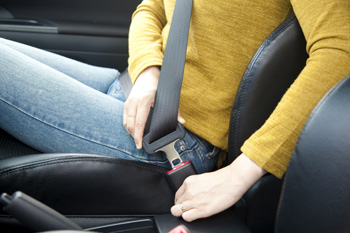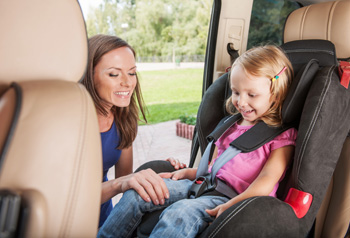According to California law, all drivers and passengers of motor vehicles must wear a seatbelt.

Wearing a seat belt is one of the easiest and essential things you can do to keep yourself safe on the road. Buckling up can also keep you from getting a fine.
The "Click It or Ticket" campaign aims to crack down on drivers and passengers not wearing seat belts.
If a passenger in your car is younger than 16 and not wearing a seatbelt, you will be given a ticket.
If the passenger is over 16, you will both receive tickets. Seat belts reduce the risk of injury or death while driving, and they must always be in good working order. Your vehicle must have enough seat belts for the number of people in the vehicle.
Remember, your seat belts must be in good condition to work properly. Have them inspected during regular maintenance checks, and be especially aware of their condition after accidents.

Child Restraint System and Safety Seats
The law requires that you properly secure all children riding in your car that are under 16 years old to a properly used restraint system such as a child booster seat (safety seat).
It is important to use a federally approved child passenger restraint system. You need to ensure the child restraint system is properly installed and reliable.
You can always contact the law enforcement agencies or fire departments in your area and ask for their guidance and help in inspecting your child restraint system. They can also refer you to a child passenger safety technician in your area.
Below are California regulations regarding child safety seats:
Exceptions to the above rule regarding the requirement of using the rear seat:
There are additional child safety rules if the vehicle has a passenger-side airbag. The child cannot ride in the front seat if he/she:
Seat Belt Myths
Some myths exist about seat belts. Below are common myths and the facts behind them.
Myth #1: You can be trapped in the car by your seat belt.
The Facts: A seat belt can keep you from being knocked unconscious during an accident, which makes it more likely that you will escape the car. It takes less than a second to remove a seatbelt.
Myth #2: Seatbelts aren't necessary if you're just taking a quick trip down the road.
The Facts: You must use your seatbelt every time you drive. More than half of deaths in accidents happen within 25 miles of the victim's home. Don't risk your life; take the two seconds to buckle your seat belt before driving.
Myth #3: People have been thrown from vehicles during accidents and walked away unharmed.
The Facts: The chance of surviving an accident is five times higher if you are not thrown from the car. A seatbelt can prevent you from being thrown. If you are thrown, you may even be hit by another vehicle and suffer greater injury.
MYTH #4: I'm just running a quick errand around the corner, and my little brother will be okay if I don't secure him in a safety seat.
The Facts: Thousands of children are critically injured or killed every year in accidents. These children can have a much better survival rate and fewer injuries if they are properly secured in a safety seat.